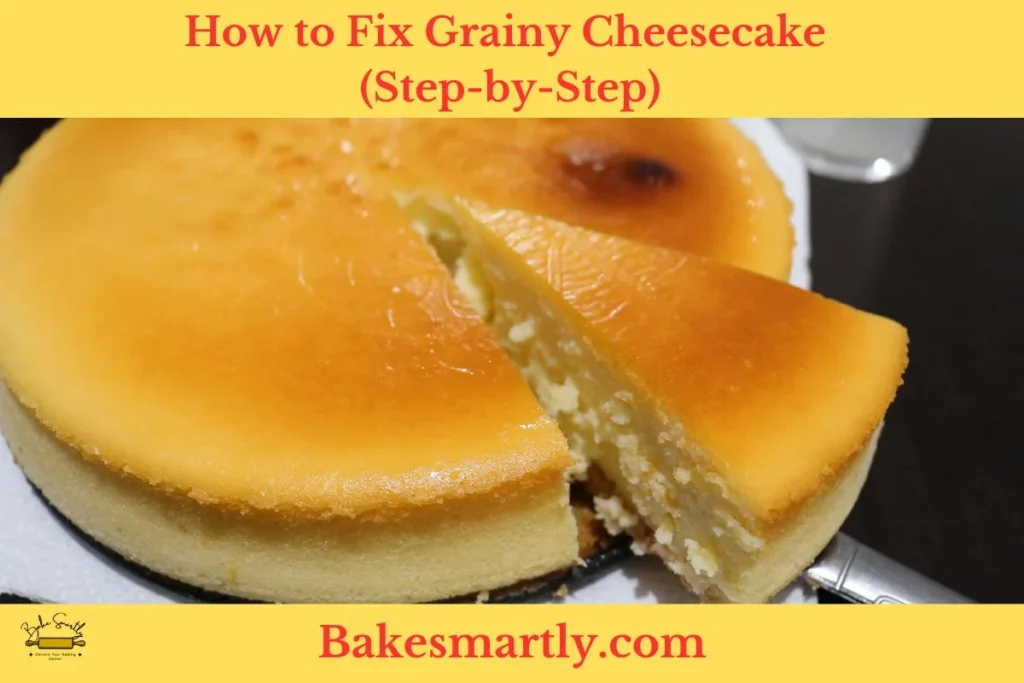
Why Is My Cheesecake Grainy | A Comprehensive Guide
Cheesecakes are a beloved dessert, known for their creamy, velvety texture. However, there’s nothing more disappointing than cutting into a cheesecake only to find it grainy. If you’ve ever wondered, “Why is my cheesecake grainy?” you’re in the right place.
In this article, we’ll explore the common reasons behind this issue and provide you with expert tips to ensure your cheesecakes turn out perfectly every time.
Table of Contents
ToggleCommon Signs of a Well-Made Cheesecake
Before we delve into the common reasons behind grainy cheesecakes, it’s essential to recognize the signs of a well-made cheesecake. Knowing what a perfectly baked cheesecake should look and taste like will help you identify any issues and troubleshoot them effectively.
A well-made cheesecake exhibits the following characteristics:
- Silky Smooth Texture: The texture of a well-made cheesecake is incredibly smooth and creamy. When you take a bite, it should melt in your mouth, leaving you with a velvety sensation.
- Uniform Color: The cheesecake’s surface should have a uniform light golden color. Any signs of overbaking, like cracks or dark spots, indicate imperfections.
- Slight Jiggle: When gently shaken, the center of the cheesecake should have a slight jiggle, while the edges remain firm. This slight jiggle indicates that the cheesecake is perfectly baked but not overdone.
- Clean Edges: The edges of a well-made cheesecake should pull away slightly from the sides of the pan as it cools. This ensures that your cheesecake won’t stick to the sides.
- Delicate Flavors: The flavors in a well-made cheesecake should be well-balanced, with a subtle tang from the cream cheese and a touch of sweetness. It should not taste overly sweet or tangy.
- Minimal Cracks: While some cracks are common, a well-made cheesecake will have minimal cracks, and they should be superficial and easy to conceal with toppings or garnishes.
Understanding these characteristics will not only help you appreciate a well-executed cheesecake but also aid in identifying issues if your cheesecake doesn’t meet these standards. Now, let’s explore why cheesecakes sometimes turn out grainy and how to avoid it.

Why Do Cheesecakes Turn Out Grainy? | 6 Main Reasons
There are times when this much-loved dessert ends up disappointingly grainy. Cheesecake’s texture is one of its key features, and when it’s not perfect, it can be a letdown. Let’s dive into the six main reasons why cheesecakes sometimes turn out grainy.
1. Mixing Too Much
One common reason for grainy cheesecake is mixing the batter too vigorously or for too long. Doing this introduces too much air into the mix, resulting in a cheesecake with a porous and grainy texture. Overmixing can also make the cheesecake puff up while baking and then collapse, leaving it with an unappealing texture.
To avoid this issue, it’s crucial to mix the cheesecake batter just until the ingredients are blended. Use a gentle touch or a low-speed mixer to prevent overmixing. The goal is to create a smooth and creamy batter without overdoing it.
2. Not Softening Cream Cheese Properly
Cream cheese is a key ingredient in cheesecakes, and its temperature matters. If you use cold cream cheese or cream cheese that hasn’t softened enough, it can lead to lumps and a grainy texture. Your cream cheese should be at room temperature when you begin mixing it with the other ingredients.
To make sure your cream cheese is soft enough, take it out of the fridge at least 30 minutes before using it. Letting it come to room temperature makes it easier to blend smoothly into the batter, resulting in a creamy and lump-free cheesecake.
3. Baking for Too Long
Baking time plays a vital role in your cheesecake’s texture. Overbaking can lead to a grainy consistency. The extra heat causes the proteins in the eggs and cream cheese to over coagulate, resulting in a dry and grainy texture.
To avoid this, follow the recommended baking time in your cheesecake recipe. Consider using a water bath too, which involves placing your cheesecake pan in a larger pan filled with hot water. This helps create a moist environment in the oven and prevents overbaking, resulting in a smoother, creamier cheesecake.
4. Using Cold Ingredients
Using ingredients that are too cold can also cause grainy cheesecakes. The cold can make the fat in the cream cheese solidify, resulting in small fat particles that give the cheesecake a grainy texture.
To prevent this, ensure that all your ingredients are at room temperature before you start mixing. This includes eggs, sour cream, and any other dairy-based components. By using ingredients at the same temperature, you’ll get a harmonious blend and a smoother texture.
5. Inadequate Mixing
While overmixing can be a problem, inadequate mixing can also lead to a grainy cheesecake. If the ingredients aren’t mixed properly, you might end up with pockets of unincorporated cream cheese or other ingredients, resulting in a less than perfect texture.
To avoid this, make sure you mix the cream cheese, sugar, and other components thoroughly until you have a uniform mixture. This ensures that all ingredients are evenly distributed, leading to a smooth and creamy cheesecake.
6. Low-Quality Ingredients
The quality of your ingredients can significantly affect your cheesecake’s texture. Using low-quality or expired cream cheese, for example, can result in a grainy and unappetizing outcome. Fresh, high-quality ingredients are essential for a successful cheesecake.
Always choose the best ingredients available, especially for cream cheese, eggs, and other dairy products. It’s a small investment that pays off with a luxurious and creamy cheesecake.

Five Tips for Preventing Graininess in Cheesecakes
Getting that perfect texture can be a bit tricky, especially when your cheesecake ends up all grainy. To help you nail the art of making a super-smooth and delicious cheesecake, here are five must-know tips to prevent that grainy texture.
- Use Top-Notch Ingredients: The key to an awesome cheesecake is using top-quality stuff. Go for fresh, high-grade ingredients like cream cheese, eggs, and dairy. Low-quality or expired ingredients can lead to graininess and mess up the flavor. Keep an eye on those expiration dates and think about splurging on premium brands for your cheesecake masterpiece.
- Soften Your Cream Cheese the Right Way: Properly softened cream cheese is crucial to avoid graininess. Make sure your cream cheese is at room temperature before using it in your recipe. Just let it sit out for around 30 minutes to an hour, and you’ll be good to go. Cold cream cheese can cause lumps that won’t mix well into the batter, resulting in an uneven texture.
- Don’t Overmix: One common cheesecake-making mistake is stirring the batter too much. Overmixing adds too much air, creating a bumpy, grainy texture. To avoid this, gently mix the ingredients until they’re just combined. Whether you’re using a hand mixer or a spatula, be gentle to keep that creamy consistency.
- Stick to the Right Baking Time and Use a Water Bath: The time your cheesecake spends in the oven is a big deal for its texture. Baking it too long can make the proteins go overboard, making it grainy. Follow the suggested baking time in your recipe, and check if it’s done by giving the pan a gentle shake. And don’t forget to use a water bath while baking. It keeps things moist, prevents overcooking, and ensures a smoother, creamier texture.
- Let It Cool Gradually: After your cheesecake is done baking, let it cool down slowly. Sudden temperature changes can cause cracks and graininess. Turn off the oven and leave your cheesecake inside with the door cracked open for about an hour. This gradual cooling process helps set the texture and reduces the risk of cracks and graininess.

How to Fix Grainy Cheesecake Step-by-Step
So, you’ve put your heart and soul into making a cheesecake, but it turned out grainy. Don’t fret – there’s a way to rescue your dessert and transform it into a smooth, creamy masterpiece. Follow this step-by-step guide to fix a grainy cheesecake and regain your cheesecake confidence.
Step 1: Assess the Situation
Before taking action, it’s crucial to examine your grainy cheesecake. Is the texture mildly grainy or excessively so? A mildly grainy texture can often be corrected with minimal intervention, while an overly grainy one might require a more comprehensive approach.
Step 2: Gently Reheat
For a cheesecake with a moderately grainy texture, gently reheating is the first step. Here’s how to do it:
- Preheat your oven to a low temperature, typically around 325°F (163°C).
- Place your cheesecake, still in its pan, in a larger pan, and add hot water to create a water bath.
- Bake the cheesecake for about 10-15 minutes.
Be cautious not to overheat, as this can further dry out the cheesecake. The goal here is to soften and redistribute the fats within the cake.
Step 3: Gradual Cooling
After reheating, turn off the oven and let the cheesecake cool gradually. Leave it in the turned-off oven for approximately an hour. This gradual cooling process helps maintain the smoothness and creaminess of your cheesecake. It allows the fats and moisture to settle back into place, potentially reducing the graininess.
Step 4: Apply a Topping
If reheating and cooling haven’t entirely smoothed out your cheesecake, you can mask imperfections by applying a delicious topping. Fruit compote, chocolate ganache, or a dusting of powdered sugar not only add flavor but also cover any remaining graininess. Your cheesecake will not only taste amazing but also look visually appealing.
Step 5: Learn and Adapt
Every baking experience, including fixing grainy cheesecakes, is an opportunity for learning. Reflect on the factors that may have contributed to the graininess – it could be your mixing technique, baking time, or ingredient quality. Use this knowledge to fine-tune your future cheesecake-making endeavors. Each cheesecake you make is a step towards mastering the art.
Step 6: Experiment with Different Recipes
Don’t be afraid to try different cheesecake recipes. Various recipes have unique instructions and ingredient combinations that might work better for your specific situation. Experimenting with different recipes can help you discover the ideal formula for creating a perfectly smooth cheesecake
Step 7: Seek Guidance
If you’re still facing issues, reach out to the baking community for advice. Online forums, recipe communities, and experienced bakers can provide valuable insights and suggestions for troubleshooting cheesecake problems. The baking community is a wealth of knowledge and support.

Troubleshooting Other Cheesecake Issues
While graininess is a common problem in cheesecakes, there are other issues that can arise during the cheesecake-making process. Here, we’ll explore some of these problems and offer solutions to help you achieve cheesecake perfection.
- Cracking: Cracks on the surface of your cheesecake can be caused by overbaking, sudden temperature changes, or overmixing. To prevent cracks, follow the recommended baking time, avoid drastic temperature shifts, and mix the batter gently. If a crack does appear, you can cover it with a delicious topping or glaze.
- Sunken Center: A sunken center can result from underbaking or sudden temperature changes. Make sure to bake your cheesecake until the edges are set, and the center has a slight jiggle. Avoid opening the oven door too early. If the center does sink, a generous layer of fruit compote or whipped cream can save the day.
- Lumpy Texture: Lumps in your cheesecake may stem from not allowing the cream cheese to reach room temperature or overmixing. Ensure your cream cheese is soft and mix the batter until just combined.
- Watery Texture: An overly watery texture could be the result of too much liquid or underbaking. Be cautious when adding flavorings and follow the recommended baking time. To salvage a watery cheesecake, refrigerate it longer, which may help it set.
- Sour Taste: An excessively sour taste may be due to an excessive amount of lemon juice or sour cream. Adjust the amount of these ingredients to achieve a milder flavor.
Why Is My Cheesecake Grainy | Final Thoughts
In conclusion, mastering the art of creating a perfect cheesecake is not only about the right ingredients and baking techniques but also understanding the common pitfalls that can lead to a disappointing, grainy texture.
A well-made cheesecake is a thing of beauty, boasting a silky-smooth texture, uniform color, slight jiggle, clean edges, and delicate flavors. By avoiding common mistakes like overmixing, using cold ingredients, and baking too long, you can ensure your cheesecakes come out velvety and delicious.
If, despite your best efforts, your cheesecake does turn out grainy, don’t despair. With gentle reheating, gradual cooling, and a tasty topping, you can often salvage your creation. Learn from your experiences, experiment with different recipes, and seek guidance from the baking community to perfect your cheesecake-making skills.
Remember that graininess is just one of the challenges you might face when making cheesecakes. Cracking, sunken centers, lumpy textures, watery consistency, or overly sour tastes can also occur. But armed with knowledge and a little practice, you’ll be well on your way to cheesecake perfection.
So, don’t be discouraged by the occasional grainy outcome—keep refining your techniques and savor the journey to creating the ultimate cheesecake. Happy baking!
Lindsey Mackenzie
Warning: Undefined variable $post in /home/u154887947/domains/bakesmartly.com/public_html/wp-content/plugins/gourmet-core/templates/blocks/gourmet-core-block-post-related.php on line 140
Warning: Attempt to read property “ID” on null in /home/u154887947/domains/bakesmartly.com/public_html/wp-content/plugins/gourmet-core/templates/blocks/gourmet-core-block-post-related.php on line 140
About me
Hi there! I’m Lindsey Mackenzie, the founder of Bake Smartly. Baking has been my passion since childhood, growing up in my father’s bakery. With Bake Smartly, I’m excited to share my love for all things sweet and savory. Join me on this delicious journey as we whip up scrumptious treats and sprinkle joy into every bite!






